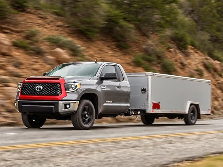
The Real Deal: What Your 2025 Toyota Tundra Can Actually Tow (And How to Do It Safely)
So, you’re eyeing a 2025 Toyota Tundra. Maybe you’ve got a boat itching to splash, a travel trailer dreaming of open roads, or a hefty work trailer that needs hauling. The big question burning a hole in your pocket? “toyota tundra towing capacity?” You’ve seen the headline numbers splashed across brochures and websites – impressive figures like 12,000 pounds! But as anyone who’s spent real time hitching up knows, towing capacity isn’t just a single magic number you pluck from the sky. It’s a conversation starter, a promise of capability, but understanding the full picture is crucial before you commit.
Let’s cut through the marketing gloss. Toyota proudly states a maximum Toyota Tundra towing capacity of up to 12,000 pounds for the 2025 model year. That’s serious muscle, putting it firmly in contention with the heavy-duty half-ton offerings. But here’s the essential truth bomb: Not every Tundra can tow 12,000 pounds. That figure represents the peak potential, achieved under very specific configurations. Your actual, real-world towing limit depends heavily on which Tundra you choose – its engine, drivetrain, cab style, bed length, and critically, the trim level and optional packages equipped. Think of it like a high score in a game; it’s achievable, but only with the right setup and skills.
This guide isn’t just about regurgitating specs. We’re diving deep into what makes the Tundra tick (or rather, tow), how different configurations impact that crucial number, the often-overlooked factors that truly dictate what you can safely pull, and the essential gear and know-how you need. Whether you’re a seasoned tower or contemplating your first big haul, understanding the nuances of the Toyota Tundra towing capacity ensures you get the right truck for your needs and, most importantly, tow with confidence and safety. Buckle up; we’re going beyond the brochure.
Under the Hood: The Engines Driving Tundra’s Towing Prowess
Gone are the days of the rumbling V8 being the sole king of tow. The 2025 Tundra lineup offers two distinct powertrains, both designed with serious hauling in mind, but with different characters and, importantly, different impacts on that maximum toyota tundra towing capacity.
-
The i-FORCE 3.5L Twin-Turbo V6: This is the standard engine across most Tundra trims. Don’t let the “V6” tag fool you – modern turbocharging works wonders. This engine churns out a robust 389 horsepower and a stump-pulling 479 lb-ft of torque. Torque, that low-end grunt, is the real hero for getting heavy loads moving and maintaining speed on inclines. Paired with a smooth 10-speed automatic transmission, this powertrain provides strong, responsive towing performance for the vast majority of needs. It’s efficient when unloaded and delivers ample power when hitched up. Most configurations with this engine max out between 11,000 and 12,000 pounds, depending on the other factors we’ll discuss.
-
The i-FORCE MAX 3.5L Twin-Turbo Hybrid V6: This is where Toyota throws the knockout punch for ultimate towing capability. Building on the standard i-FORCE, the MAX adds an electric motor/generator nestled within the transmission. The result? A staggering 437 horsepower and an earth-moving 583 lb-ft of torque. That torque figure is the key – it’s available incredibly low in the rev range, right where you need it to launch a heavy trailer. This hybrid system isn’t primarily about fuel sipping while towing (though it helps in certain scenarios); it’s about delivering instantaneous, massive torque. This is the powertrain that unlocks the full, advertised 12,000-pound Toyota Tundra towing capacity. If you consistently tow at the upper limits of the half-ton spectrum or prioritize effortless acceleration with a load, the i-FORCE MAX is worth serious consideration.
Both engines are mated to a robust 10-speed automatic transmission featuring dedicated tow/haul modes. These modes adjust shift points for better power delivery and increased engine braking when descending hills, crucial for controlling heavy trailers. The key takeaway? While the standard i-FORCE is impressively capable, the i-FORCE MAX hybrid is the undisputed champion for maximizing the Toyota Tundra towing capacity and delivering the most effortless towing experience, especially with hefty loads.
It’s Not Just the Engine: Configuration’s Critical Role
You’ve picked your powertrain – MAX for max towing, or the standard i-FORCE for strong capability. But hold on! The truck’s physical build significantly influences what it can safely pull. Toyota doesn’t slap a 12,000-pound rating on every single Tundra rolling off the line. Here’s how the build sheet affects your toyota tundra towing capacity:
-
Cab & Bed Combo: This is fundamental. The maximum tow ratings are only achievable with the CrewMax cab paired with the 6.5-foot bed (often referred to as the “short bed” CrewMax). Why? This configuration provides the optimal wheelbase length for stability when towing heavy loads. A longer wheelbase is inherently more resistant to trailer sway. Choosing the Double Cab (smaller rear doors, less rear seat space) or opting for the CrewMax with the ultra-rare 8.1-foot bed alters the weight distribution and wheelbase, typically resulting in a lower maximum tow rating, often in the 10,000 to 11,500-pound range depending on other options. If max towing is your absolute priority, the CrewMax/6.5′ bed is non-negotiable.
-
Drive Type: 4×4 or 4×2? While 4×4 systems add weight and some mechanical complexity, their impact on the maximum toyota tundra towing capacity is usually minimal or non-existent for 2025 models. Where 4×2 (rear-wheel drive) might have held a slight edge years ago, modern engineering and weight management have largely closed this gap. The benefits of 4×4 – traction on slippery boat ramps, muddy job sites, or snowy highways – often far outweigh any fractional theoretical weight advantage of 4×2 for most towers. Focus on your need for traction; the max tow rating itself is generally the same between comparable 4×2 and 4×4 models with the same cab/bed/powertrain/trim.
-
Trim Level & Packages: This is where the rubber meets the road (or the hitch meets the trailer). Higher trim levels (like Platinum, 1794, Capstone, TRD Pro) often come with more standard equipment – larger wheels/tires, premium sound systems, power accessories, moonroofs – all of which add weight. This consumes payload capacity (more on that next), which indirectly impacts towing. Crucially, reaching the absolute maximum Toyota Tundra towing capacity of 12,000 pounds requires specific packages:
-
The Tow Package: This is usually standard or easily added on most trims and includes essentials like a heavy-duty trans cooler, upgraded alternator, and the integrated trailer brake controller.
-
The TRD Off-Road Package (on applicable trims) OR Certain Premium Packages: Counterintuitively, adding off-road gear like skid plates and off-road suspension can slightly reduce the maximum tow rating compared to a similarly equipped truck without those specific off-road components, due to added weight and suspension tuning priorities. To hit 12,000 lbs, you typically need a truck without the TRD Off-Road package on trims where it’s optional. Always check the specific tow rating listed on the window sticker of the exact truck you’re considering – it’s the law and the definitive answer for that VIN.
-
The Silent Killer: Payload Capacity and Why It Matters More Than You Think
If there’s one concept every potential tower must engrave in their mind, it’s this: Payload capacity is often the real limiter, not the headline towing capacity. It’s the unsung hero (or villain) of the towing world.
-
What is Payload? Think of it as the truck’s “weight budget.” It’s the maximum total weight of everything you can load into and onto the truck itself. This includes:
-
All passengers and their gear (kids, spouses, dogs, coolers).
-
Everything in the bed (tools, firewood, ATVs, dirt bikes, camping gear).
-
Aftermarket accessories (tonneau covers, toolboxes, lift kits, bigger tires).
-
And critically, the tongue weight of your trailer.
-
-
The Tongue Weight Connection: This is the big one. A properly loaded trailer typically exerts a downward force (tongue weight) equal to 10-15% of the trailer’s total weight on the truck’s hitch. So, a 10,000-pound trailer means 1,000 to 1,500 pounds of tongue weight. This tongue weight counts directly against your payload capacity.
-
The Math That Bites: Let’s say your Tundra has a payload capacity of 1,700 pounds (a common figure for a well-equipped CrewMax 4×4). If your family and gear in the cab weigh 600 lbs, and you have 200 lbs of tools in the bed, that’s 800 lbs used up. Now, you hitch up a trailer with 1,200 lbs of tongue weight. 800 lbs + 1,200 lbs = 2,000 lbs. You’ve just exceeded your payload capacity by 300 lbs, even though the trailer itself might only weigh 10,000 lbs (well below the truck’s max tow rating)! This is dangerous and illegal.
Finding your truck’s actual payload capacity is paramount. It’s listed on a yellow and black sticker inside the driver’s door jamb – never rely solely on generic brochure figures. A truck rated to tow 12,000 lbs might only have a 1,500 lb payload. If the tongue weight for that 12k trailer is 1,500 lbs (12.5%), you have zero payload left for passengers, fuel, or a spare tire! Exceeding payload stresses the suspension, brakes, and frame, dramatically increasing the risk of an accident. Always prioritize payload calculations over the flashy max tow number.
Beyond the Numbers: Real-World Factors Affecting Your Towing Experience
Okay, you’ve got the truck spec’d right (CrewMax/6.5′ bed, i-FORCE MAX, correct packages) and you’ve meticulously calculated your payload. You’re good for 12,000 lbs, right? Technically, yes. But the experience and safety of towing that load depend heavily on factors beyond the factory rating:
-
Trailer Loading & Balance: This is arguably the most critical skill for safe towing. An improperly loaded trailer is a nightmare waiting to happen.
-
Weight Distribution: Aim for 60% of the cargo weight forward of the trailer’s axles, 40% behind. This ensures adequate tongue weight (10-15% of total trailer weight) for stability. Too little tongue weight causes dangerous sway; too much overloads the truck’s rear axle.
-
Secure Everything: Loose cargo shifting inside a trailer changes the center of gravity dynamically, inducing sway or worse. Use high-quality straps, chains, and blocking. Double-check everything.
-
Tire Pressures: Both truck and trailer tires must be inflated to their cold pressure ratings as specified on their sidewalls or the trailer placard, not the door jamb pressure (which is for unloaded conditions). Underinflation generates heat and is a leading cause of blowouts, especially on heavy trailers.
-
-
The Right Hitch: Don’t cheap out here.
-
Weight Distribution Hitch (WDH): For trailers over about 5,000 lbs, a WDH is not just recommended; it’s essential. It uses spring bars to distribute a portion of the tongue weight back to the trailer axles and, crucially, forward to the truck’s front axle. This:
-
Restores steering control and front-end traction.
-
Levels the truck, improving headlight aim and overall stability.
-
Reduces stress on the truck’s rear suspension.
-
-
Hitch Class & Receiver: Ensure your hitch receiver (the part bolted to the truck’s frame) is rated for the weight. Class IV (up to 10,000 lbs GTW / 1,000 lbs TW) or Class V (up to 12,000-17,000 lbs GTW / 1,200-1,700 lbs TW) are standard for heavy half-ton towing. The hitch ball and shank must also be rated appropriately.
-
-
Integrated Trailer Brake Controller: The Tundra’s built-in controller (standard with tow package) is fantastic. Never tow a trailer with electric or electric-over-hydraulic brakes without a functioning brake controller. It synchronizes the trailer brakes with the truck’s brakes, providing crucial stopping power. Adjust the gain setting based on load – the trailer wheels should brake firmly without locking up. Practice in a safe area.
-
Environmental Conditions: Towing 12,000 lbs on a calm, flat interstate is one thing. Doing it through mountain passes in high winds or torrential rain is another. Anticipate significantly reduced performance:
-
Braking Distances: They can double or triple. Leave enormous following distances.
-
Acceleration & Hill Climbing: Be patient. The hybrid’s torque helps, but physics is physics. Downshift manually using the transmission’s tow/haul mode on long grades to control speed and prevent overheating.
-
Crosswinds & Buffeting: Large trailers act like sails. Be prepared for constant steering corrections, especially when passed by semis. Reduce speed in windy conditions.
-
Heat Management: Monitor engine and transmission temps (gauges are your friend!). Pull over if things get excessively hot. Ensure radiator fins are clean.
-
How Does the 2025 Tundra Stack Up? A Quick Competitive Glance
The half-ton truck market is fiercely competitive, especially regarding towing. Here’s how the 2025 Tundra’s towing capacity holds up against key rivals:
| Competitor | Max Towing Capacity (2025) | Key Towing Engine | Notable Towing Features |
|---|---|---|---|
| Toyota Tundra | Up to 12,000 lbs | i-FORCE MAX Hybrid (437hp/583 lb-ft) | Standard Integrated Brake Controller, Robust Frame |
| Ford F-150 | Up to 13,000 lbs (14K w/ HDPP) | 3.5L EcoBoost High-Output (450hp/510 lb-ft) | Pro Trailer Backup Assist, Onboard Scales (Opt.) |
| Ram 1500 | Up to 12,750 lbs | 5.7L Hemi eTorque (Optional) (395hp/410 lb-ft) | Rear Air Suspension (Opt.), Trailer Tire Pressure Mon. |
| Chevrolet Silverado 1500 | Up to 13,300 lbs | 6.2L V8 / 3.0L Duramax Diesel (Opt.) | Advanced Trailering System, Trans. Camera (Opt.) |
| GMC Sierra 1500 | Up to 13,300 lbs | Same as Silverado | MultiPro Tailgate, Similar Trailering Tech |
| Nissan Titan | Up to 9,310 lbs | 5.6L Endurance V8 (400hp/413 lb-ft) | Standard Integrated Brake Controller, Robust Build |
Analysis: The Tundra’s 12,000 lb rating is competitive, sitting solidly in the upper echelon of standard half-tons. While Ford and GM offer slightly higher max numbers (often requiring specific, less common configurations like the F-150’s Heavy-Duty Payload Package or max-tow setups), the Tundra i-FORCE MAX hybrid delivers unmatched low-end torque (583 lb-ft), which translates to phenomenal pulling power off the line and on grades. Its fully boxed frame and standard integrated brake controller are significant strengths. The Ram offers clever air suspension options, while Ford and GM lead in some high-tech trailer assistance features. The Tundra’s value lies in its robust engineering, hybrid torque advantage, and strong overall capability without needing ultra-niche packages to reach its max.
Essential Gear for Safe & Stress-Free Tundra Towing
Having the right truck is step one. Equipping it properly is step two for safe and enjoyable towing:
-
Weight Distribution Hitch (WDH) with Sway Control: As discussed, non-negotiable for heavier loads. Brands like Equal-i-zer, Husky Centerline, and Blue Ox are popular and reliable. Get it professionally set up initially.
-
Properly Rated Hitch Ball and Shank: Match the ball size (typically 2″ or 2 5/16″ for heavy loads) and weight rating to your trailer’s coupler. Use a high-quality, forged shank. Never use adapters for heavy towing.
-
Safety Chains: Always crossed under the tongue! Rated for the trailer’s GVWR.
-
Trailer Brake Controller: Thankfully, integrated and standard on Tundras with the tow package. Know how to use it!
-
Trailer Wiring Harness & 7-Pin Connector: Ensure flawless operation of all trailer lights (running, brake, turn signals). Test them every time you hitch up. Carry spare fuses.
-
Trailer Tire Pressure Monitoring System (TPMS): A worthwhile investment. Blowouts are incredibly dangerous when towing; a TPMS gives you early warning of pressure loss or overheating.
-
Quality Mirrors: The Tundra’s mirrors are good, but large trailers often require extended towing mirrors for adequate rearward visibility. Consider clip-ons or OEM extensions if needed.
-
Basic Toolkit & Spares: Wheel chocks, lug wrench that fits trailer wheels, spare trailer tire (if possible), jack capable of lifting the trailer, extra fuses, electrical tape, gloves.
Conclusion: Towing Confidence Starts with Understanding
The 2025 Toyota Tundra stands tall as a genuinely capable hauler, with a towing capacity reaching a competitive 12,000 pounds when properly equipped with the i-FORCE MAX hybrid, CrewMax cab, 6.5-foot bed, and the necessary packages. That headline number represents impressive engineering. However, the true measure of towing success lies far beyond that single figure.
Respecting payload capacity – that yellow sticker in the door jamb – is the absolute cornerstone of safe towing. It’s the silent governor that often bites unsuspecting towers. Mastering trailer loading and balance is an art form essential for stability. Investing in the right hitch (especially a quality WDH) and ensuring all connections (electrical, safety chains) are flawless are non-negotiable steps. Understanding how environmental conditions dramatically affect performance and practicing defensive driving techniques are critical for navigating real-world challenges.
The Tundra provides a robust platform: a torque-monster hybrid option, a strong frame, and excellent standard towing features like the integrated brake controller. It empowers you to tow big. But that empowerment comes with the responsibility to equip yourself with knowledge and the right gear. Do your payload math, balance your load meticulously, use the essential equipment, and respect the physics of moving massive weight. When you combine the Tundra’s inherent capability with informed and careful towing practices, you unlock not just the ability to move your boat, camper, or equipment, but the genuine confidence to enjoy the journey. Now, go hook up and explore – safely and smartly.
Toyota Tundra Towing Capacity FAQs: Your Burning Questions Answered
Here are answers to the most common questions we hear about pulling power:
-
“Okay, be honest, can my specific Tundra really tow 12,000 lbs?”
-
Probably not every Tundra. Check two things: 1) Your window sticker (look for the “Max Trailer Weight” spec), and 2) The yellow payload sticker in your driver’s door jamb. The window sticker tells you the max the truck is rated for in its specific build. The payload sticker tells you the max weight you can add (people, gear, tongue weight). The lower of these two numbers, constrained by tongue weight requirements, is your practical limit. Only specific configs (CrewMax/6.5′ bed, i-FORCE MAX, no heavy off-road packs) hit 12k.
-
-
“Payload vs. Towing Capacity – I’m confused. Which one matters more for me?”
-
Payload is almost always the limiting factor first, especially in half-ton trucks. Towing capacity is the max weight behind you. Payload is the max weight on you (including the trailer’s tongue weight). It’s very easy to max out your payload with passengers, gear, and tongue weight long before you hit the max towing number. Always, always know your payload and calculate your tongue weight + everything in/on the truck.
-
-
“Do I really need that fancy weight distribution hitch? They’re expensive!”
-
For trailers over roughly 5,000 lbs? Absolutely, 100% yes. It’s not just about the weight; it’s about control, stability, and safety. A WDH restores steering feel, keeps the truck level (so headlights point correctly), prevents rear suspension sag, and significantly reduces trailer sway. It’s crucial insurance for heavy loads. Don’t skip it.
-
-
“I’ve got the hybrid. Does it get better gas mileage while towing?”
-
Don’t expect miracles. The i-FORCE MAX’s primary towing advantage is its massive torque (583 lb-ft), making acceleration and hill climbing much easier. While the hybrid system can help in specific scenarios (like low-speed maneuvering or providing electric boost during acceleration), the overall fuel economy while towing a heavy load is still dominated by the gas engine working hard. You might see a slight advantage over a non-hybrid in certain conditions, but the main benefit is the effortless power, not necessarily significant MPG gains under max load.
-
-
“The sales guy said I don’t need a brake controller for my car hauler trailer. Is he right?”
-
NO! Run away! If your trailer has brakes (which any trailer over about 3,000 lbs absolutely should have for safety), you MUST have a functioning brake controller synchronized to the truck’s brakes. The Tundra’s integrated controller is excellent. Relying solely on the truck’s brakes to stop a heavy trailer is dangerous, illegal in most places for trailers over a certain weight, and will lead to drastically increased stopping distances and potential loss of control. Always use a brake controller.
-






